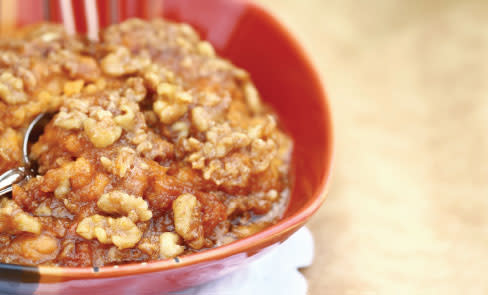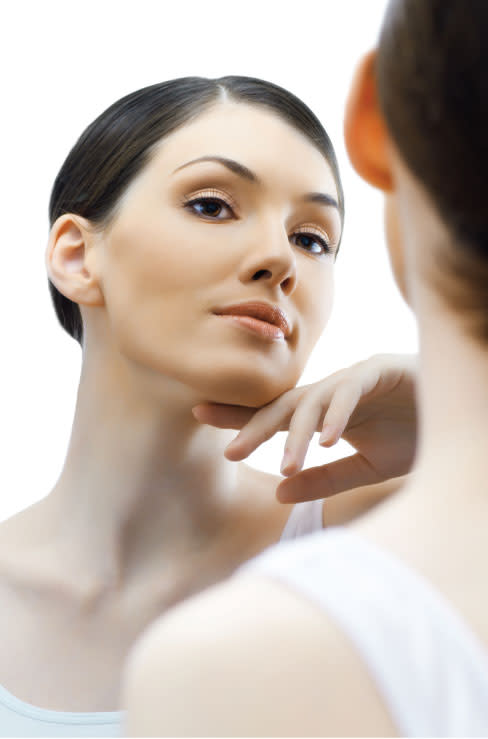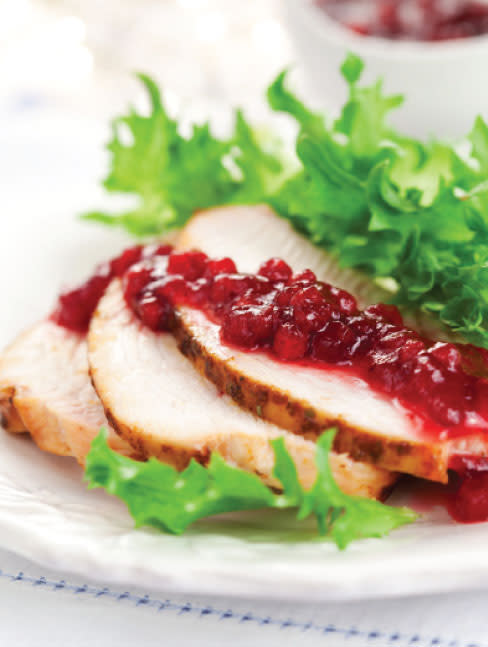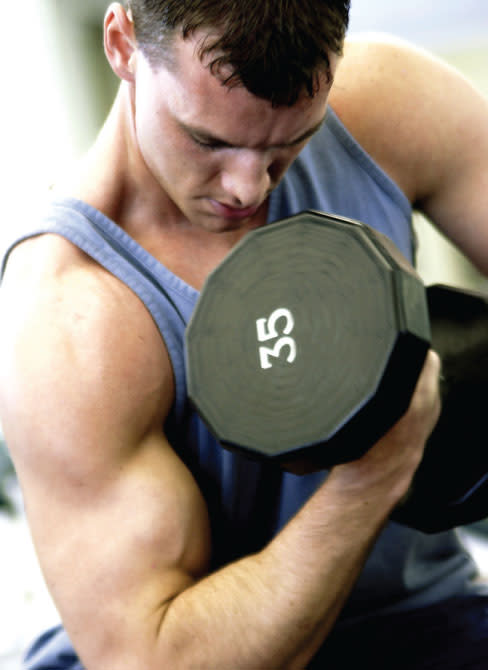Health Report: November 2012
The latest 3-D imagery for your body, a yummy Thanksgiving recipe, and fitness tips from a pro.
A Balanced Feast
Add this healthy alternative to your Thanksgiving menu.

Thanksgiving's classic sweet potato casserole doesn't have to be loaded with butter and excess sugar. This slimmed-down version, from chef Sisavath Keovilay and student Zuleynka Llinas of Keiser University's Sarasota Center for Culinary Arts, uses heart-healthy olive oil instead of butter and substitutes some of the sugar with Florida-friendly citrus honey. And the craisins make for a sweet-and-tart homage to Thanksgiving's favorite fruit.
Roasted Walnut and Craisin Crusted Yam Casserole
Yields six to eight three-ounce portions
Ingredients
5 medium-size yams
1 cup whole wheat bread crumbs
½ cup citrus honey
⅛ teaspoon nutmeg
¼ teaspoon cinnamon
½ cup roasted walnuts
2 tablespoons extra virgin olive oil
½ cup craisins
2 tablespoons brown sugar
½ teaspoon salt
Procedure
Wash yams and roast in a pre-heated oven at 350 degrees for 45 minutes. While the yams are roasting, combine bread crumbs, craisins, brown sugar, cinnamon, nutmeg, walnuts and olive oil in a large mixing bowl. Once the yams are roasted, allow them to rest for 30 minutes, then peel and slice the yams into one-inch-thick discs. In a mixing bowl, add the yams, honey and salt, and then mix well. Pour the yam and honey mixture into a medium-size casserole dish, then sprinkle the combined bread crumbs mixture on top. Bake for 35 minutes at 350 degrees or until the crust is a toasty brown.
Stopping Skin Cancer Before It Starts

Approximately 58 million Americans have actinic keratosis, the most common precancer of the skin, which can lead to squamous cell carcinoma. Carcinoma rates are higher closer to the equator, but you can do some things to protect yourself.
What to look for: Red, scaly growths, often more than one inch in diameter, on sun-exposed areas like the hands and face (especially the lips, nose, ears and bald scalp).
Who's at higher risk: People with fair skin, blond or red hair, and blue or green eyes; people with long-term sun exposure, a history of sunburns (especially early in life) and older people.
The latest treatment: Red light phototherapy, which selectively targets and destroys abnormal cells, can penetrate deeper than its "blue light" predecessor. The technology is faster, less intrusive and less painful than traditional treatments like excision, electrodesiccation and cryosurgery. Phototherapy allows dermatologists to be more proactive in treating present issues and preventing future problems with "less of an ordeal," according to Dr. Cathy Milam of Milam-Bogart Dermatology, currently the only practice in Sarasota offering both red and blue light treatments. "We've used red light a lot over the past year and continue to be more impressed with its effectiveness," she says. Plus, "having [both red and blue] options allows us to better tailor treatment to the patient's needs."
Don't blame the turkey

Need a post-Thanksgiving nap? It's not the turkey's fault. Tryptophan, an amino acid and essential nutrient (which means your body can't produce it; it needs to be supplied by your diet), is what your body uses to make serotonin, a chemical that helps you sleep. And tryptophan can be found in, among other things, turkey. That's why it's long been cited as the reason you feel so tired after your Thanksgiving meal.
In truth, tryptophan is also present in dairy, peanuts, tofu and other poultry. In fact, there's actually more tryptophan in chicken than in turkey. But you never think tryptophan after a trip to KFC.
So, if it's not the turkey, why are you so sleepy after Thanksgiving dinner? In part, it's actually the carbohydrates that trigger a chemical chain reaction that leads to the serotonin boost. But most of all, feeling sluggish is a natural reaction to overeating, as your body concentrates its energies on digestion.
Coach's Corner

Trainer and former Baltimore Orioles strength and conditioning coach John Selzler urges caution when pursuing the latest high-intensity workout trends. Here's what he has to say:
''For people who choose 'extreme' training without asking, 'What qualifies this person to train me?' or 'Why is this workout good for me?', give me a call when you blow out a disc in your back or your knees and rotator cuff are shredded. I'll do my best to get you moving again. Or save your money by just going to youtube.com. You'll find a bunch of workouts—all of which are equally inappropriate for you personally.
It sounds harsh, but the scenario is very real. When incorporating the high-risk exercises that these programs are known for, there's little thought put into adjusting the workout to the individual's limitations. Is the risk of a lifetime of back, knee or shoulder pain worth all the hype? Don't get me wrong: Those exercises are great, when monitored properly. Proper spotting and proper progressions need to be administered by educated and experienced training staff so that dangerous situations can be avoided. If a trainer is oblivious to what can happen, he or she will not be able to prevent the worst. ''
Why so SAD?
Even in the Sunshine State, Seasonal Affective Disorder (SAD) can take its toll. The condition, which seems like depression in people who are relatively content the rest of the year, is caused by the decrease in daylight that occurs during the winter months. Northern areas (where the daylight change is more drastic) present greater risk, of course, but Sunshine State residents can still experience the symptoms, which include fatigue, carbohydrate craving and weight gain.
Treatment options vary (and those who suspect they may be suffering instead from depression should consult a mental health professional), including natural options like melatonin, St. John's wort and vitamin D, as well as light-exposure therapies. Making sure to spend time outside during the winter may help, and some scientists even suggest adjusting your circadian rhythm by getting up earlier, in order to expose yourself to more morning light.
And something to keep in mind come longer days and warmer weather: According to the National Alliance on Mental Illness, approximately one-tenth of SAD cases are instead triggered in the summer—possibly by heat and humidity.
5 percent of Americans suffer from full-blown SAD
The Future You—In 3D
Once cosmetic surgeons had only two-dimensional photos and descriptive language to help their patients visualize surgical results, but now a brand-new imaging system and software work together to create three-dimensional images of how patients look now, and how they could look after certain procedures.
First, in a process that takes less than 30 seconds, the Vectra 3M imaging system uses six high-definition cameras to capture the body and assemble it into a three-dimensional mockup on a computer screen. Then the surgeon can use Sculptor software to show how the patient's body would be changed by procedures like liposuction, facelift, rhinoplasty and facial fillers. "We use it a lot in breast augmentation," says Dr. Scott Engel of Sarasota Plastic Surgery Center, which began using Vectra and Sculptor this spring. "We can rotate the body so they can see it from different angles. We can put in different implants, and they can see, 'Is this too big for me? Too small? Is it going to make my hips look bigger?'"